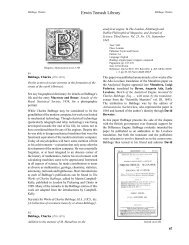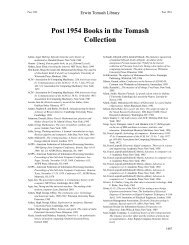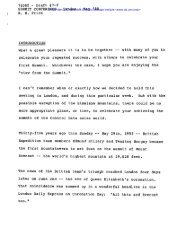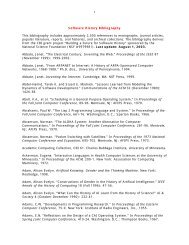M chapter.indd - Charles Babbage Institute
M chapter.indd - Charles Babbage Institute
M chapter.indd - Charles Babbage Institute
Create successful ePaper yourself
Turn your PDF publications into a flip-book with our unique Google optimized e-Paper software.
830<br />
Erwin Tomash Library<br />
Magini, Giovanni Antonio Magini, Giovanni Antonio<br />
Year: 1592<br />
Place: Venice<br />
Publisher: Batistam Ciottum<br />
Edition: 1st<br />
Language: Latin<br />
Binding: later patterned boards<br />
Pagination: ff. [4], 36 (misnumbered 34 as 62 and 36 as 64)<br />
Collation: a 4 A–I 4<br />
Size: 194x146 mm<br />
Giovanni Magini earned a degree in philosophy from the<br />
University of Bologna in 1579. In 1588, he was chosen<br />
over the younger Galileo to occupy one of the two chairs<br />
of mathematics in Bologna. Modern comparisons with<br />
Galileo have often been to Magini’s detriment, but he<br />
was regarded highly during his lifetime. He proved to<br />
be a reasonable scholar, corresponded with Brahe and<br />
Galileo on astronomical matters, published the first<br />
detailed atlas of Italy and made a number of original<br />
astronomical observations. It has been noted that he<br />
sided with others against Galileo, but such actions were<br />
not unusual at the time and were often conducted with a<br />
bitterness that seems entirely out of place today.<br />
Even before the invention of logarithms, a number of<br />
shortcuts were available for the performance of complex<br />
arithmetic calculations. Perhaps the best known of<br />
these was the method of prosthaphaeresis (see entry<br />
for Clavius, Christoph; Astrolabium, Rome, 1593).<br />
Other approaches involved finding the squares and<br />
square roots of quantities. The large amount of work<br />
involved in applying these methods often obviated<br />
their use. However, they indeed proved to be useful if a<br />
table of squares could be consulted to quickly obtain an<br />
approximate value.<br />
M 17<br />
Magini calculated this table of squares for precisely such<br />
use. It lists the squares of each integer from 1 to 10,100.<br />
His examples (as were Napier’s a few years later when<br />
he invented logarithms) are oriented towards arithmetic<br />
involving sines because these were heavily used in<br />
astronomy, astrology and navigation. Magini shows that<br />
given x, one can find its square root by looking in the<br />
table for two perfect squares that bracket x, and then<br />
it is simply a matter of subtraction to find a very close<br />
approximation to its square root. In modern notation:<br />
x = a 2 + y, x = (a+1) 2 – z,<br />
√x = a + y/z<br />
These tables are a separate issue of the tables that are<br />
part of Magini’s work De planis triangulis that appeared<br />
in the same year. The same setting of type was used as<br />
can be seen from the last page of the tables where the<br />
catchword Tavola appears in the lower corner because<br />
in De planis triangulis a table titled Tabula Sinuum<br />
followed the table of squares. This volume is dedicated<br />
to Tycho Brahe, but that dedication is not part of the<br />
larger work.<br />
Illustrations available:<br />
Title page<br />
Last table page<br />
M 18<br />
Magini, Giovanni Antonio (1555–1617)<br />
Primum mobile duodecim libris contentum, in quibus<br />
habentur trigonometria sphæricorum, et astronomica,<br />
gnomonica, geographicaque problemata, ac præterea<br />
magnus trigonometrius canon emendatus, et auctus,<br />
ac magna primi mobilis tabula ad decades primorum<br />
scrupulorum per utrumque latus supputata.<br />
b/w: Magini, Giovanni Antonio; Tabulæ generales<br />
ad primum mobile spectantes, et primo quidem<br />
sequitur magnus canon mathematicus, 1609.<br />
b/w: Magini, Giovanni Antonio; Tabula proportionalis<br />
ad usum generalis primi mobilis, 1609.<br />
Year: 1609<br />
Place: Bologna<br />
Publisher: For the author by Jo. Bapt. Bellagambam<br />
Edition: 1st<br />
Language: Latin<br />
Figures: engraved title page<br />
Binding: contemporary half-vellum over boards; raised bands<br />
Pagination: ff. [9], 104, [1], 106 – 290 (misnumbered 4 as 7,<br />
110 as 109, 141 as 241, 142 as 242, 146 as 246, 233 as<br />
236, 250 as 248, 251 as 249)<br />
Collation: π 3 b 4 c 2 A–4B 4 4C 6<br />
Size: 355x238 mm<br />
Reference: DSB IX, pp. 12–13







